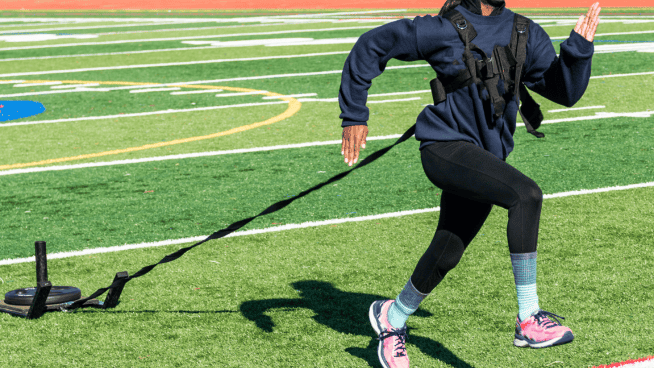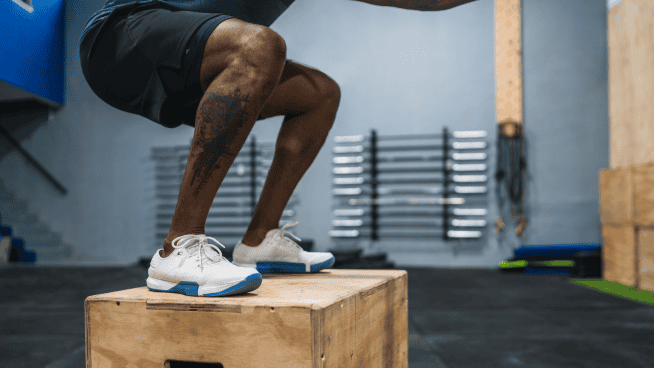3 Exercises to Build Overhead Stability for Swimmers
Like many other overhead athletes, one common error in beginner swimmer weight programs includes overhead pressing motions thought to help improve strength in a sport-specific motion. However, I argue that this rationale is flawed, and there are safer and more effective ways to improve overhead stability in swimmers.
Unfortunately, swim coaches don’t always have the budget to hire a certified strength and conditioning coach to write a proper program. To be fair, that swim coach is doing everything to the best of their knowledge to improve their athlete’s performance. Most swim coaches don’t have a strength and conditioning background, and with the plethora of information and videos online, it is easy to get lost amongst all the viral videos of professional athletes performing their exercise program. What they forget is that each program is individually tailored for each athlete, and there are certain exercises that are not adequate for certain athletic populations.
Performing a military or shoulder press with a dumbbell or barbell is not an adequate variation due to the fact that it isolates the shoulder joint and creates a lot of stress on the shoulder joint, which are often unstable in swimmers.
I remember my first two years of collegiate swimming doing seated shoulder presses for weights thinking it would improve my upper body strength in the pool. My shoulders always had a pinching sensation, and my low back was flopping off the bench. When I got in the water, I always felt that my shoulder strength never really improved, and they were stuck in the mud. So why should a swimmer avoid an overhead press, and what exercises can we use to provide better overhead stability?
Overhead Stability for Swimmers
The glenohumeral joint (GH) or shoulder joint is a ball and socket joint capable of movement in many planes. The movement of the shoulder does not just revolve at the GH joint but also in the acromioclavicular (AC), sternoclavicular (SC), and the scapulothoracic joint. Unfortunately, increased stress from certain activities can cause certain deficiencies and adaptations. In swimmers, the two primary reasons why overhead pressing is not a good option for strength exercises are overuse and joint laxity/instability in the shoulder.
Overuse
Swimmers spend their time with their arms directly above their heads in the catch phase of their strokes for countless meters. Performing this movement repeatedly is demanding. Poor stroke mechanics and lack of time to recover in between practices can create imbalances in the shoulder musculature. Muscles such as subscapularis and serratus anterior are consistently active and are more prone to fatigue (Martino and Rodeo, 2018). Asking a year-round swimmer with countless yards on their body and poor overhead joint health to press overhead is placing the more unneeded load on the shoulder joint.
Laxity and Instability
Laxity is normal in joints, but overuse begins to create pathological laxity. For a swimmer, increased laxity in the glenohumeral joint can create an advantage by creating a longer stroke length and improves their speed (Martino and Rodeo, 2018). The drawback to this is that this advantage can decrease the strength of the stabilizers in the shoulder in charge of the translation of the humeral head and GH kinematics (Martino and Rodeo, 2018). This further leads to muscles around the joint being overloaded, fatigued, which leads to an increased rate of injury. Due to this instability, most swimmers will find discomfort from being in a loaded overhead position.
Exercise to Build Overhead Stability
So what exercises should be used to create better overhead stability in swimmers?
Dead Bug/Lumbopelvic Stability Exercises
Before beginning to create proper overhead stability, a coach should look at whether or not an athlete is stable at the lumbopelvic region (this is assuming they have proper mobility overhead). Oftentimes swimmers have not done proper anterior core strengthening and lack the hip stability to press a weight overhead. A review of multiple works of literature from Cope et al. (2019), looked into lumbopelvic control and its effect on shoulder injuries in overhead athletes. What they found was that the studies all concluded that improved lumbopelvic control not only improves athletic performance but reduces the risk of a shoulder injury.
If a swimmer has inadequate shoulder flexion, they sometimes cheat to get into that position by hyperextending from the lumbar spine. The problem with this position is that they are using their lumbar spine to create stability, which creates an unnecessary shear force, which can lead to further injury in the low back. It is important to take advantage of each exercise and maximize its potential so an athlete can improve performance.
A sure way to improve this imbalance is through lumbopelvic stability exercises such as the dead bug.
I suggest trying 3-5 sets and as many as 10-12 repetitions each side maximum. If you or your athlete struggle to get, the rhythm starts with isometric holds beginning for 10-15 seconds each side. Other exercises that teach lumbopelvic stability are core marches, straight leg raises, hollow holds, or for the more advanced a PRI 90/90 hip lift.
Turkish Get-Up
The Turkish Get-Up (TGU), as well as many other, get up variations are great exercises to build overhead stability, core strength, hip mobility, and kinesthetic awareness. By taking the weight from a horizontal to a more vertical position, the athlete can take their time to create stability for the shoulders. The TGU has been shown to reinforce GH stability by training the muscles and motor patterns that control scapular position and movement (Ayash and Jones, 2012). A study by St-Onge used EMG on eight muscles of the shoulder during the TGU, 7 of which crossed the GH joint. What they found was that those seven muscles were active during the exercise, which contributes to the benefits of the TGU and to GH stability.
The TGU is one of the best exercises that provides a great bang for your buck. In fact, it is sometimes used in a prehab setting since it requires one to emphasize full-body movement and is a pain-free isometric shoulder and cervical spine contraction (Shaw, 2019). I suggest 3-4 sets with 1-3 reps per side maximum because this is neurally taxing. Other variations include the ½ TGU, or for the advanced, the Czech Get Up.
Landmine Press Variations
The Landmine Press is a great alternative for pressing because the vector of the bar goes at an angle and works a full range of motion for a press. This also teaches proper upward rotation of the scapula and body alignment that strengthens shoulder stability. If anyone has shoulder flexion restrictions, the landmine is a fantastic alternative. For more advanced athletes, the landmine carries great loading potential for bilateral and unilateral exercises as well as variations that are easier on the shoulder than traditional overhead pressing.
There are a few variations for the landmine press, and all are great to develop overhead stability for a swimmer. I suggest 2-10 reps each side, depending on if one is aiming for strength or power. The landmine press is versatile and can be progressed by load, position, or desired rate of force production.
Conclusion
The shoulder of a swimmer is complex and requires some TLC. This can be done by proper exercise prescription to help build overhead shoulder stability that does not put one’s health in danger. These exercises are options that one can use to build better shoulder stability for a swimmer. There are also other great exercises such as handstands, armbars, windmills, and bottoms up variations that were not covered. By understanding the complexity of the shoulders for swimmers, proper measures can be taken to keep an athlete healthy and improve their performance.
RECOMMENDED FOR YOU
MOST POPULAR
3 Exercises to Build Overhead Stability for Swimmers
Like many other overhead athletes, one common error in beginner swimmer weight programs includes overhead pressing motions thought to help improve strength in a sport-specific motion. However, I argue that this rationale is flawed, and there are safer and more effective ways to improve overhead stability in swimmers.
Unfortunately, swim coaches don’t always have the budget to hire a certified strength and conditioning coach to write a proper program. To be fair, that swim coach is doing everything to the best of their knowledge to improve their athlete’s performance. Most swim coaches don’t have a strength and conditioning background, and with the plethora of information and videos online, it is easy to get lost amongst all the viral videos of professional athletes performing their exercise program. What they forget is that each program is individually tailored for each athlete, and there are certain exercises that are not adequate for certain athletic populations.
Performing a military or shoulder press with a dumbbell or barbell is not an adequate variation due to the fact that it isolates the shoulder joint and creates a lot of stress on the shoulder joint, which are often unstable in swimmers.
I remember my first two years of collegiate swimming doing seated shoulder presses for weights thinking it would improve my upper body strength in the pool. My shoulders always had a pinching sensation, and my low back was flopping off the bench. When I got in the water, I always felt that my shoulder strength never really improved, and they were stuck in the mud. So why should a swimmer avoid an overhead press, and what exercises can we use to provide better overhead stability?
Overhead Stability for Swimmers
The glenohumeral joint (GH) or shoulder joint is a ball and socket joint capable of movement in many planes. The movement of the shoulder does not just revolve at the GH joint but also in the acromioclavicular (AC), sternoclavicular (SC), and the scapulothoracic joint. Unfortunately, increased stress from certain activities can cause certain deficiencies and adaptations. In swimmers, the two primary reasons why overhead pressing is not a good option for strength exercises are overuse and joint laxity/instability in the shoulder.
Overuse
Swimmers spend their time with their arms directly above their heads in the catch phase of their strokes for countless meters. Performing this movement repeatedly is demanding. Poor stroke mechanics and lack of time to recover in between practices can create imbalances in the shoulder musculature. Muscles such as subscapularis and serratus anterior are consistently active and are more prone to fatigue (Martino and Rodeo, 2018). Asking a year-round swimmer with countless yards on their body and poor overhead joint health to press overhead is placing the more unneeded load on the shoulder joint.
Laxity and Instability
Laxity is normal in joints, but overuse begins to create pathological laxity. For a swimmer, increased laxity in the glenohumeral joint can create an advantage by creating a longer stroke length and improves their speed (Martino and Rodeo, 2018). The drawback to this is that this advantage can decrease the strength of the stabilizers in the shoulder in charge of the translation of the humeral head and GH kinematics (Martino and Rodeo, 2018). This further leads to muscles around the joint being overloaded, fatigued, which leads to an increased rate of injury. Due to this instability, most swimmers will find discomfort from being in a loaded overhead position.
Exercise to Build Overhead Stability
So what exercises should be used to create better overhead stability in swimmers?
Dead Bug/Lumbopelvic Stability Exercises
Before beginning to create proper overhead stability, a coach should look at whether or not an athlete is stable at the lumbopelvic region (this is assuming they have proper mobility overhead). Oftentimes swimmers have not done proper anterior core strengthening and lack the hip stability to press a weight overhead. A review of multiple works of literature from Cope et al. (2019), looked into lumbopelvic control and its effect on shoulder injuries in overhead athletes. What they found was that the studies all concluded that improved lumbopelvic control not only improves athletic performance but reduces the risk of a shoulder injury.
If a swimmer has inadequate shoulder flexion, they sometimes cheat to get into that position by hyperextending from the lumbar spine. The problem with this position is that they are using their lumbar spine to create stability, which creates an unnecessary shear force, which can lead to further injury in the low back. It is important to take advantage of each exercise and maximize its potential so an athlete can improve performance.
A sure way to improve this imbalance is through lumbopelvic stability exercises such as the dead bug.
I suggest trying 3-5 sets and as many as 10-12 repetitions each side maximum. If you or your athlete struggle to get, the rhythm starts with isometric holds beginning for 10-15 seconds each side. Other exercises that teach lumbopelvic stability are core marches, straight leg raises, hollow holds, or for the more advanced a PRI 90/90 hip lift.
Turkish Get-Up
The Turkish Get-Up (TGU), as well as many other, get up variations are great exercises to build overhead stability, core strength, hip mobility, and kinesthetic awareness. By taking the weight from a horizontal to a more vertical position, the athlete can take their time to create stability for the shoulders. The TGU has been shown to reinforce GH stability by training the muscles and motor patterns that control scapular position and movement (Ayash and Jones, 2012). A study by St-Onge used EMG on eight muscles of the shoulder during the TGU, 7 of which crossed the GH joint. What they found was that those seven muscles were active during the exercise, which contributes to the benefits of the TGU and to GH stability.
The TGU is one of the best exercises that provides a great bang for your buck. In fact, it is sometimes used in a prehab setting since it requires one to emphasize full-body movement and is a pain-free isometric shoulder and cervical spine contraction (Shaw, 2019). I suggest 3-4 sets with 1-3 reps per side maximum because this is neurally taxing. Other variations include the ½ TGU, or for the advanced, the Czech Get Up.
Landmine Press Variations
The Landmine Press is a great alternative for pressing because the vector of the bar goes at an angle and works a full range of motion for a press. This also teaches proper upward rotation of the scapula and body alignment that strengthens shoulder stability. If anyone has shoulder flexion restrictions, the landmine is a fantastic alternative. For more advanced athletes, the landmine carries great loading potential for bilateral and unilateral exercises as well as variations that are easier on the shoulder than traditional overhead pressing.
There are a few variations for the landmine press, and all are great to develop overhead stability for a swimmer. I suggest 2-10 reps each side, depending on if one is aiming for strength or power. The landmine press is versatile and can be progressed by load, position, or desired rate of force production.
Conclusion
The shoulder of a swimmer is complex and requires some TLC. This can be done by proper exercise prescription to help build overhead shoulder stability that does not put one’s health in danger. These exercises are options that one can use to build better shoulder stability for a swimmer. There are also other great exercises such as handstands, armbars, windmills, and bottoms up variations that were not covered. By understanding the complexity of the shoulders for swimmers, proper measures can be taken to keep an athlete healthy and improve their performance.










